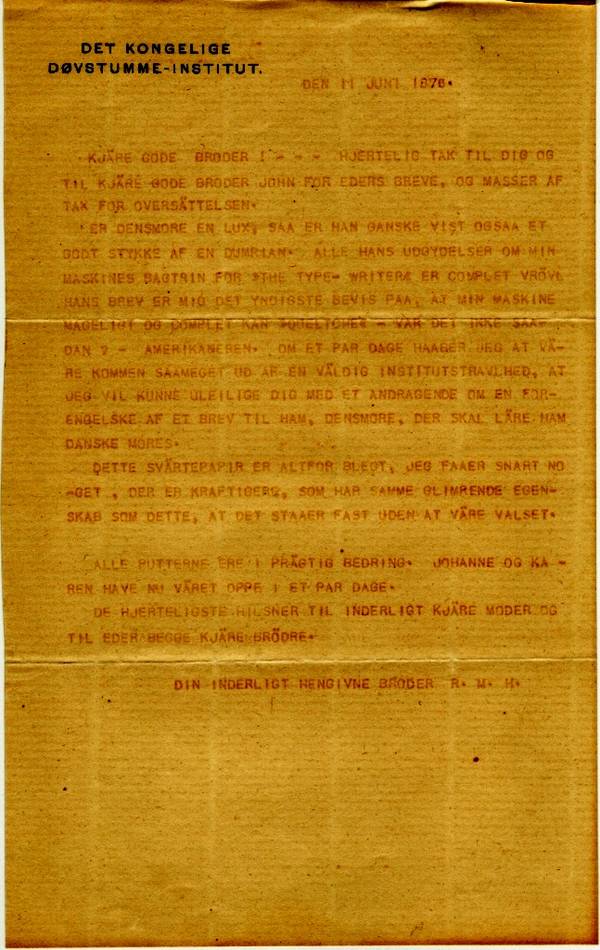1876.06.11 English
THE ROYAL INSTITUTE
FOR THE DEAF-MUTE
JUNE 11, 1876
MY DEAR B R O T H E R ! _ _ _ THANK YOU SO MUCH TO YOU AND DEAR BROTHER JOHN FOR YOUR LETTERS AND Y WARMEST THANKS FOR THE TRANSLATION. DENSMORE MAY BE A LUX[1], BUT STILL HE IS ALSO A BIT OF A FOOL. ALL HIS OUTPOURINGS ABOUT THE DISADVANTAGES OF MY MACHINE IN RELATION TO “THE TYPE-WRITER” ARE COMPLETE NONSENSE. HIS LETTER[2] IS, IN ITSELF, TO ME THE MOST EXQUISITE PROOF THAT MY MACHINE CAN COMFORTABLY AND COMPLETELY “QUELTOME”[3] – ISN’T THAT THE EXPRESSION? – THE AMERICAN. IN A COUPLE OF DAYS TIME I HOPE TO HAVE EMERGED SO MUCH OUT OF A PERIOD OF EXTREME INSTITUTIONAL PRESSURE OF WORK THAT I MAY BE ABLE TO TROUBLE YOU WITH A PETITION ABOUT A TRANSLATION INTO ENGLISH OF A LETTER TO HIM, DENSMORE, WHICH INTENDS TO TEACH HIM SOME DANISH MORES[4].
THIS INK-PAPER IS FAR TOO DULL. BUT VERY SOON I WILL GET ANOTHER PRODUCT THAT IS STRONGER AND WITH THE SAME EXCELLENT QUALITIES AS THIS ONE, NAMELY THAT IT IS FIXED WITHOUT BEING ROLLED[5] ON THE PLATEN.
ALL THE TODDLERS ARE RECOVERING BEAUTIFULLY. JOHANNE AND KAREN HAVE NOW BEEN UP AND ABOUT FOR A COUPLE OF DAYS.
WARMEST REGARDS TO DEAR SWEET MOTHER AND TO BOTH OF YOU DEAR BROTHERS.
YOUR DEEPLY DEVOTED BROTHER R.M.H.
[1] JMC: RMH’s reference is somewhat enigmatic, because we don’t know the time-bound meaning of this word, probably used in a slang connotation at the time. “Lux” today is a unit of illuminance. It is used in photometry as a measure of the intensity of light. Lux is a derived unit based on ‘lumen’, and lumen is a derived unit based on ‘candela’. The word is Latin for ‘light’, and of course RMH knew Latin. It is our best guess that he used it as an expression of an enlightened or brilliant person.
[2] CB: This is probably the letter the brother has translated into Danish. One is constantly amazed that the extremely intelligent and highly educated RMH cannot even read a letter in English – after so many years of struggle against the American ‘type-writers’ – and corresponding with Densmore – who, as we know, was the legal advisor of the competitor in the United States. It is quite beyond our understanding how RMH benefitted anything whatsoever from this relationship – and even more incomprehensible why, in the first place, he entered this communication.
[3] CB : This word does not exist in English – and this goes to show his inadequacy in that language.
JMC: I believe he has mistaken a French word for an English one: The intention is probably to say: my machine can ‘knock him over’, i.e. can beat him any time. ‘tomber’ is French for ‘to fall, to tumble’
[4] CB: This is a pun on the name Densmore and Danish ‘mores’ (Latin for ‘customs’). It is obvious that RMH is by now furious with Densmore.
[5] CB: This is a somewhat enigmatic statement, indicating that when RMH has typed a letter on the writing ball, he subsequently sends the letter through a printing cylinder in order for the ink to be more permanently fixed to the paper. We should keep in mind that not until 1878/79 the writing ball was issued with a colour ribbon. Before that time, a carbon paper was placed on top of the paper, and hence one could not see what was being typed, while typing. Sverre: However, according to a previous letter, the carbon paper was only fix at one side in order to allow for the use to lift it up and see, what was being written. CB: Perhaps it is because of this cylinder (also called ‘platen’) that RMH creates his third big invention – the Xerographia – in which there is this very cylinder which works as a ‘copying machine’

